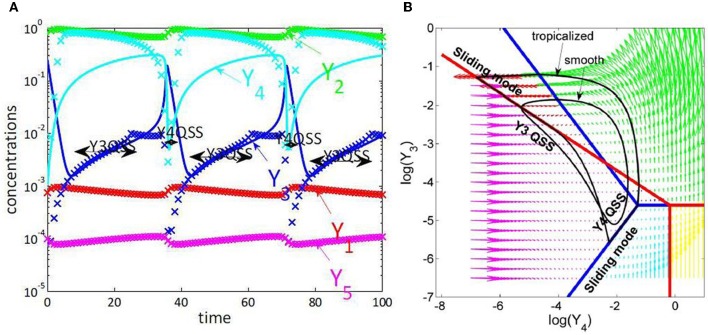Figure 4.
Tropical geometry and cell cycle modeling. We considered the five variables cell cycle model defined by the differential equations y′1 = k9y2 − k8y1 + k6y3, y′2 = k8y1 − k9y2 − k3y2y5, y′3 = k′4y4 + k4y4y23/C2 − k6y3, y′4 = −k′4y4 − k4y4y23/C2 + k3y2y5, y′5 = k1 − k3y2y5, proposed in Tyson (1991). (A) Comparison of trajectories and imposed trajectories show that variables y1, y2, y5 are always slaved, meaning that the trajectories are close to the 2 dimensional hyperplane defined by the QE condition k8y1 = k9y2, the QSS condition k1 = k3y2y5 and the conservation law y1 + y2 + y3 + y4 = C. The variables y3, y4 are slaved and the corresponding species are quasi-stationary on intervals. This means that the dimensionality of the dynamics is further reduced to 1, on intervals. (B) Tropicalization on logarithmic paper, in the plane of the variables y3, y4. The tropical manifold consists of two tripods, represented in blue and red, which divide the logarithmic paper into six polygonal sectors. Monomial vector fields defining the tropicalized dynamics change from one polygonal domain to another. The tropicalized (approximated) and the smooth (not reduced) limit cycle dynamics stay within bounded distance one from another. This distance is relatively small on intervals where the variables y3 or y4 are quasi-stationary, which correspond to sliding modes of the tropicalization.

